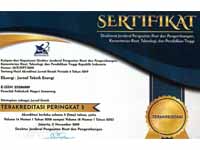Study of Designing Electrical Energy Plants With Feedback Method From Generator Output
DOI:
https://doi.org/10.32497/eksergi.v18i3.3662Keywords:
Generators, Feedback, New Energy.Abstract
The use of electricity has now become a primary need for people who are used for activities as an energy source such as: lights, air conditioners, water pumps, washing machines, TVs, etc. and the longer the need for electrical energy in Indonesia is increasing while power plants are constantly increasing, this forces the government to continue to build power plants to meet the needs of electrical energy in the community. Of course, the construction of this power plant uses very large costs and various obstacles, one of the obstacles is that fuel that used to be a power plant used a lot of oil, now switches to gas and coal to reduce high electricity production costs. The research method that will be carried out is by feeding the generator output back into a rotor drive energy source so that there is a continuous circulation of energy so that the generator output can be charged according to the remaining power capacity fed by the generator. Based on the test results, results were obtained using a 25 Watt DC motor when the input voltage was 12 Volts the power generated on the motor was 13.8 Watts with a motor speed of 768 rpm. Testing on an 800 Watt generator obtained a maximum rpm result of 764 and a vout of 13.8 volts. the highest input voltage (Vin) obtained was 10.06 volts, the output voltage (Vout) was 3.9 volts, and the power produced was 41.34 Watts. The prototype design that was tested produced energy even though the results were still not significant.
References
Al-Fikri, H. I. 2014. Analisis Pembangkit Listrik Dengan Generator Stirling. Jurnal Teknik Elektro Universitas Tanjungpura, 1(1).
Anonim, 2008, Energy Systems Engineering Technology, Idaho State University
Asy”™ari Hasyim., Jatmiko., Ardiyatmoko Azis., 2012, Desain Generator magnet permanen kecepatan rendah untuk pembangkit listrik tenaga angin atau bayu (PLTB)” Seminar Nasional Aplikasi Teknologi Informasi, Yogyakarta.
Budiman Wildan, dkk., 2014, Perancangan dan realisasi sistem pengisian baterai 12 Volt 45 Ah pada pembangkit listrik tenaga Pikohidro di UPI Bandung, Jurnal Reka Elkomika. Vol.2 No.1, januari 2014, p 1-12
Djaufani Beny Muhamad, dkk., 2015, Perancangan dan realisasi kebutuhan kapasitas baterai untuk beban pompa air 125 Watt menggunakan pembangkit listrik tenaga surya, Jurnal Reka Elkomika. Vol.3 No.2, juli 2015, p 75-86
Habibi Afnan Muhammad, dkk., “Kajian penggunaan motor listrik DC sebagai penggerak speedboat”, Universitas Brawijaya, Malang.
Sdiyarto., 2010, “Dampak Perubahan Putaran Terhadap Unjuk Kerja Motor Induksi 3 Phasa Jenis Rotor Sangkar”, Jurnal Kompetensi Teknik. Vol.1 No2, Mei 2010, p 57-64
Khairi Agung, Amien Syamsul., 2014, Analisis pengaruh jatuh tegangan terhadap torsi dan putaran pada motor arus searah penguat shunt”, Jurnal Singuda Ensikom. Vol.6 No.2, Februari 2014, p 54-59
Mismail Budiono., 2011,”Sistem tenaga dan telkomunikasi jilid 3”, UB Press, Malang
Nazaruddin Nazris., 2011,” Pembuatan inverter satu phasa berbasis mikrokontroler dengan gelombang sinus untuk kontinuitas pelayanan listrik”, Jurnal Poli Rekayasa. Vol.7 No.1, januari 2014, p 18-30
Putra, R. P., Samsurizal, S., & Pahiyanti, N. G. 2018. Desain Sistem Kontrol Penggerak Mula Generator Magnet Permanen PLTMH Menggunakan Planetery Gear. KILAT, 7(2), 149-159.
Portela Pedro., Sepulveda Joao., Esteves Sena Joao., 2008, Alternating Current and Direct Current Generator, International Journal on hands on science, The hands-on scienc network. Vol.1 No1, November 1, September 2008, p 44-46
Sarjan Muhammad., 2011, “perbandingan karakteristik motor induksi belitan gelung dengan belitan spiral”, Jurnal ilmiah foristik. Vol.1 No.1, Maret 2011, p 6-15
Waroh p.y. Anthoinete., 2013,”Analisis dan simulasi sistem pengendali motor DC”, Jurnal ilmiah Sains. Vol.14 No.2, Oktober 2014, p 80-86
Yoakim Simamora, Samsurizal, Zalmahdi. 2018. Pembagian Pembangkitan Sistem Pembangkit Termal Pada Kondisi Beban Yang Berubah Terhadap Waktu Menggunakan Quadratic Programming. Energi & Kelistrikan, 10(1), 78-83. https://doi.org/10.33322/energi.v10i1.331
Downloads
Published
Issue
Section
License
Authors who publish with this journal agree to the following terms:Authors retain copyright and grant the journal right of first publication with the work simultaneously licensed under a Creative Commons Attribution License that allows others to share the work with an acknowledgement of the work's authorship and initial publication in this journal.
Authors are able to enter into separate, additional contractual arrangements for the non-exclusive distribution of the journal's published version of the work (e.g., post it to an institutional repository or publish it in a book), with an acknowledgement of its initial publication in this journal.
Authors are permitted and encouraged to post their work online (e.g., in institutional repositories or on their website) prior to and during the submission process, as it can lead to productive exchanges, as well as earlier and greater citation of published work (See The Effect of Open Access).






